Thursday, 18 December 2014
research: Artist Emma McNally- carbon dreamscapes
Emma McNally’s drawing, Carbon Cleaving, brings different ways of describing space together: cartographies, technological spaces, telecommunications, flight paths, tracks and transmissions. The materials used to create these spaces of transformation include paper, graphite, chalk, tissue and holes and metal pins that impregnate the soft paper surface. She writes: ‘I like graphite’s materiality: its mess and dirt as well as its capacity to leave the cleanest, sharpest percussive marks and lines. I feel like I’m forging land formations when I use it, or scattering particles, or spiralling vortices of smoke and water’
emma mcnally's flickr account
 |
| Emma McNally Carbon Cleaving 2010 |
artist: Doris Salcedo- melancholy and memory
The artist’s work is an ongoing exploration of how to address and articulate violence and loss. The objects she makes are works of intimate remembrance. Travelling through Colombia with humanitarian groups, Salcedo gains inspiration from the testimonies of people who are struggling to rebuild their lives after suffering the loss of a family member. She acts as a witness, meditating on the loss of freedom and human life in a country enduring a culture of collective fear—the result of years of civil war, drug-related crime, state-sanctioned torture and executions.
The materials she works with: simple furniture like wardrobes, tables and chairs, clothing, thread and animal skin, speak of the sanctity and familiarity of everyday domestic life. Through her molding or reshaping of these pieces - embedding a chair within a doorframe, grafting two tables into an unstable hybrid - she creates a traumatized, dysfunctional, object.
Research: works of Tim Knowles
 |
| Nightwalk - Valley of Rocks #1 |
i love the ambiguity and dramatic lighting of this shot
Artists statement about the tree works
|
I use apparatuses, mechanisms, or systems beyond my control to introduce chance into the production of my art. The pieces here are from a series produced by trees, most of which are located in the Borrowdale and Buttermere areas of England’s Lake District. I attach artists’ sketching pens to their branches and then place sheets of paper in such a way that the trees’ natural motions—as well as their moments of stillness—are recorded. Like signatures, each drawing reveals something about the different qualities and characteristics of the various trees as they sway in the breeze: the relaxed, fluid line of an oak; the delicate, tentative touch of a larch; a hawthorn’s stiff, slightly neurotic scratches. Process is key to my work, so each Tree Drawing is accompanied by a photograph or video documenting the location and manner of its creation.
|
 |
| full moon series: reflections of full moon on water |
2013
Single channel 12 hour HD videoA slowly shifting film made up of 9004 digital pinhole photographs taken consecutively during a walk across Mungo National Park, from its Western border to its Eastern border. The film [the sequence of images constantly cross dissolving one into the next] gives a Turneresque impression of the journey through Mungo's varied landscape of grasslands, dried up lake bed, dunes, Mallee forest, etc.The landscape in this Australian based video is familiar in it's colours and wildness. I like the camera shake, the dream-like quality. |
I love the strong concept behind the work, the use of chance to create the images, but ultimately the artist is choosing which iamges to keep/discard/show. like the chance element to the work, capturing time with traces. THe artist has also started using montage of still photos to make video-work which I'm interested in. Following of from a video project combining stills and short sharp bursts of abstract video footage, I would like to pursue this as a way of combining a number of abstract images to create mood. |
ideas: japanese designer Naoya Matsumoto- working with light and paper
Local studio Naoya Matsumoto Design created the small Yorunoma bar behind a typical glass shopfront in the Abeno-Ku ward of Osaka.
The crinkly surfaces were formed from lengths of rumpled tracing paper, sculpted by the designer and local residents to achieve a textured, rock-like appearance across the angular walls and ceiling.
http://www.naoyamatsumoto.com/
article from : http://www.dezeen.com/2014/12/18/naoya-matsumoto-design-crumpled-paper-grotto-bar-osaka-japan/
The crinkly surfaces were formed from lengths of rumpled tracing paper, sculpted by the designer and local residents to achieve a textured, rock-like appearance across the angular walls and ceiling.
http://www.naoyamatsumoto.com/
article from : http://www.dezeen.com/2014/12/18/naoya-matsumoto-design-crumpled-paper-grotto-bar-osaka-japan/
Paperwork inspiration: SIMON SCHUBERT
http://www.dezeen.com/2012/05/28/paper-works-by-simon-schubert/
The artist Simon Schubert (born 1976) graduated from the academy of Fine Arts Kunstakademie Düsseldorf, Germany (sculpture master class of Professor Irmin Kamp).
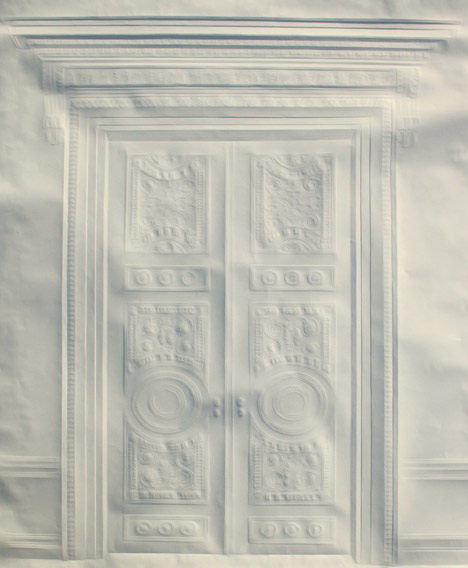
Simon Schubert, who mentions authors Samuel Beckett and Edgar Allan Poe as his biggest influences, raises the most existential and fundamental questions. Loneliness, isolation, loss and disappearance are the reoccurring issues in his paper works and sculptures. The mysterious and unsettling atmosphere his works radiate confronts the viewer with his own subconscious fears and anxieties.
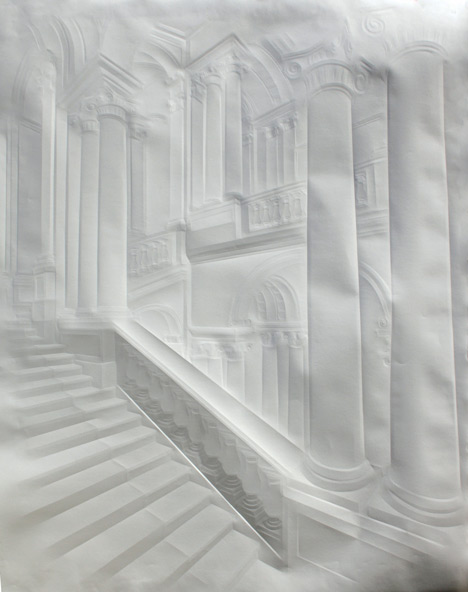
In his paper works Schubert folds and creases the sheets in an extraordinary technique, adding a plastic quality to the plain paper without any graphical aid. Staircases and hallways, insights of stately homes are shown, seemingly on the point of dissolution. The rooms are inhabited by hidden human figures whose ghost-like shadows seem to enter or leave the scene.
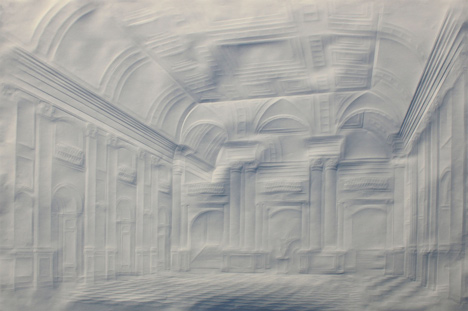
The paper works are made of plain paper. The papers are entirely folded and uncoloured.
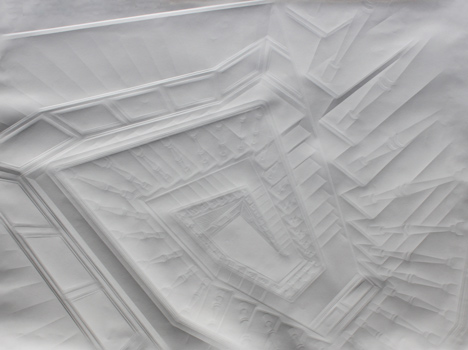
The three dimensionality of the picture is a result of a special technique. The lines, angles and circles are raised several millimetres as the result of positive and negative folding. Those reliefs change in the interplay of shadow and light and move between two and three dimensionality.
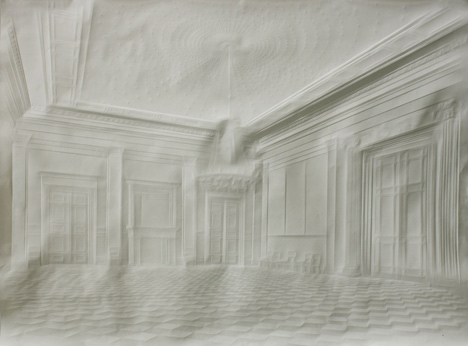
In different lighting, like the changing of daylight, the pictures change from nearly vanishing into an illusion of space and three-dimensionality.
Simon Schubert lives and works in Cologne, Germany.
Sunday, 14 December 2014
101 Women Artists Who Got Wikipedia Pages This Week | ARTnews
101 Women Artists Who Got Wikipedia Pages This Week | ARTnews
How did I miss this in june
Brilliant piece of cultural activism
https://en.wikipedia.org/wiki/Wikipedia:Meetup/ArtAndFeminism#Results
How did I miss this in june
Brilliant piece of cultural activism
https://en.wikipedia.org/wiki/Wikipedia:Meetup/ArtAndFeminism#Results
Saturday, 13 December 2014
inspiration: female photographers- Lottie Davies
Lottie Davies:
contemporary female UK photographer
First saw her entry 'Quints' for the Taylor Wessing Photography Prize at the National Gallery in 2008.
Love the rich colours, narrative and dream like quality of her work
research:Susan Hiller
Susan Hiller
Gallery representation:
Ingleby Gallery london
Source:
http://www.susanhiller.org/
http://www.tate.org.uk/art/artists/susan-hiller-1286
http://www.inglebygallery.com/artist/
Inspiring
Memory, subconscious, rituals, subtlety, memory and memorial
Susan Hiller
What I like
about Susan Hellers works is the impact of something geometric or reassuringly
familiar ‘objects’ with an underlying meaning that is more intriguing.
The layers and
thoughts that have gone into this.
The importance
of memory, personal experience and unconscious thoughts/automatic writing to
the creation of a work.
I like the
blatant distance that the artist also puts between the viewer and her work.
Burning works that no-one will see. The use of familiar (to me) scientific type
storage jars, that now seem other-worldly and dated which adds a nostalgic/lost
time dimension to the works.
I’m still not
sure how much I wish to take into account a viewers subjective history when
they see a work and how this will affect their interaction with a piece.
How much to
manipulate an experience of a piece of art based on how much information you
give away.
I think this is
what steers me clear of mainly figurative pieces, playing with what I want to
convey, or wrap up in layers of symbolism and meaning.
Bio
Susan Hiller was born
in 1940 and grew up in and around Cleveland, Ohio until 1952 when her family
moved to South Florida where she attended local schools and Coral Gables High
School. She was awarded a scholarship to Smith College in
Northampton, Massachusetts, and graduated in 1961. After a year in
New York studying film and photography at The Cooper Union and archaeology and
linguistics at Hunter College, Hiller went on to do postgraduate
work at Tulane University in New Orleans with a National Science
Foundation fellowship in anthropology. She conducted fieldwork in Mexico,
Guatemala and Belize but became uncomfortable with academic anthropology's
claim to objectivity; she wrote that she did not wish her research to become
part of anthropology's 'objectification of the contrariness of lived events'. During
a lecture on African art, she made the decision to leave anthropology to become
an artist.
Susan Hiller has been based mainly in London since the early
1960’s. After several exhibitions of her paintings and a series of
collaborative ‘group investigations’, in the early 1980’s she began to make
innovative use of audio and visual technology. Her groundbreaking
installations, multi-screen videos and audio works have achieved international
recognition and are widely acknowledged to be a major influence on younger
British artists.
Each of Susan Hiller’s works is based on specific cultural
artifacts from our society, which she uses as basic materials. Many of her
works explore the liminality of certain phenomena including the practice of
automatic writing (Sisters of Menon, 1972/79; Homage to Gertrude Stein,
2010), near death experiences (Channels, 2013), and collective experiences of
unconscious, subconscious and paranormal activity (Dream Mapping,
1974; Belshazzar’s Feast, 1983-4; Dream Screens, 1996;Psi Girls, 1999; Witness,
2000). In describing this area of Hiller’s work, art historian Dr. Alexandra
Kokoli draws attention to its palpable political subtext: “Hiller’s work
unearths the repressed permeability ... of ... unstable yet prized constructs,
such as rationality and consciousness, aesthetic value and artistic canons.
Hiller refers to this precarious positioning of her oeuvre as 'paraconceptual,'
just sideways of conceptualism and neighbouring the paranormal, a devalued site
of culture where women and the feminine have been conversely privileged. Most
interestingly, in the hybrid field of 'paraconceptualism,' neither
conceptualism nor the paranormal are left intact ... as ... the prefix 'para'
-symbolizes the force of contamination through a proximity so great that it
threatens the soundness of all boundaries."
With a practice extending
over 40 years, Susan Hiller is considered one of the most influential artists
of her generation. Her work is found internationally in both private
and public collections and her career has been recognized by mid-career survey
exhibitions at London’s Institute of Contemporary Arts (1986)
and Tate Liverpool (1996), and, most recently by, a major
retrospective exhibition at Tate Britain (2011).
Friday, 12 December 2014

thinking ahead to installations/further 3-D work and objects I might be interested in using. Have been collecting wishbones from family meals for a while. Cleaned them using hydrogen peroxide which also bleaches them a stark plaster-like white
thinking about casting wishbones so looking at other artists using them
I loved seeing Kate McGuire's work in the RWA last year as part of a Coates and Scarry exhibit.
Curled works of feathers in sculpted forms, still and serpent-like in wooden glass cabinets, giving them an otherworldly appearance and interesting context.
ongoing installation project
12.12.14 installation work
trying to push on from initial dust projection prints.
Working towards idea of light/projection installation using old-school projector and slides.
The concept is about the familiarity (for old farts like me) with the regular sound of projector, the hum, the visible dust haze in the beam, and the doziness and heat and associations that come from being in a room watching slides.
This is a scanned dust slide using just sellotape and sampling dust from the largest oldest room in the art school.
I'm interested in referencing traces of the past. The art school in Bristol has been here since 1853. Like any home, parts of it are unchanged, others bits left untouched. There are obvious associations with dust and history.
I like this particular image as the dust collected unexpectedly looks like an eye gazing back.
I'm trying to avoid coming back to deliberately framing my images which seems to be a recurring familiar almost comfort blanket.
However in this case it works better with a black outline.
Thursday, 11 December 2014
Uta BARTH
11th december
researching other artists interested in light/the viewer who use similar imagery familiar to me
use of windows/curtains/light
Uta Barth
Friday, 5 December 2014
video research
https://www.youtube.com/watch?v=jwGLdhuD1lQ
 Liked the fact
that he didn’t for ages realize he was referencing a childhood experience and
that this impact on him, a near death experience, flavours his work with a
spiritual element which adds more depth to an already beautiful an eery
approach to his work.
Liked the fact
that he didn’t for ages realize he was referencing a childhood experience and
that this impact on him, a near death experience, flavours his work with a
spiritual element which adds more depth to an already beautiful an eery
approach to his work.
Bill Viola
Watched a video
of the artist talking about his inspiration on Tate shorts
 Liked the fact
that he didn’t for ages realize he was referencing a childhood experience and
that this impact on him, a near death experience, flavours his work with a
spiritual element which adds more depth to an already beautiful an eery
approach to his work.
Liked the fact
that he didn’t for ages realize he was referencing a childhood experience and
that this impact on him, a near death experience, flavours his work with a
spiritual element which adds more depth to an already beautiful an eery
approach to his work.
I particularly
liked
Bill Viola -
Tristan's Ascension – 2005
The theatrical
lighting gives this a sense of immediacy or a live performance, which is then
blurred and confused as the viewer struggles to understand what is happening
and how the video is filmed,
It shows a body
prone, covered in white, suggesting a death shroud, water in larger and larger
quantities seems to travel upwards from the figure giving the film a sense of
movement and ascension of the body, as the water density increases, so does the
light intensity, albeit obliterating the previously visible body, adding to the
sense of ‘ascension’.
Unsettling,
dramatic and impactful.
installation pieces
 |
|
4.12.14 installation |
In my studio space there's a patch of wall that's white and been visibly painted over time and time again, the brush strokes timeless in contrast to a patch of dated woodchip wallpaper that reminded me of home and inumerable bloody magnolia coloured rooms I've lived and stayed in over the years.
Again it's about the white. I still have no idea why. It doesn't matter
This piece is cut from that cast, it has pieces of paint and has poorly picked up the texture so I decided to use as a frame (again..).
The window shape is a recurring image that preoccupies me.
Years ago daydreaming out of a similar looking one when I should have been revising. Dreaming of writing scripts and film school, not the future I ended up following. Fast forward 20 years, and I'm now back in an art school with the same windows. This time the day dreaming's encouraged. It's different to the one I stare out of a work that's been tinted to save on aircon and is as modern as you like.
I went round sampling dust with sellotape from hard to reach nooks and crannies. Projecting these on acetate created a blurred nothingness that seemed to indistinct. The above image, is the cast scanned with the dust taped bits in between. Makes me think of christmas cake icing and cinnamon.
Thursday, 4 December 2014
Anna Franceschini - Laws of Attraction
video artist
impressions:
random, liked the use of light, tension, little sound to distract-muted low growl-like bass notes that may or may not have been the sound slowed down.
Slightly haunting location for a film anyway, the ghost ride, haunted house, all forced fear, jumpy laughs and old-school nostalgia.
Something hypnotic and nauseating about watching the images of the big dipper and rides.
Eery sense of being left there at night, abandoned as there are no other visible people.
Jarring more lengthy shots of a pair of legs in manicles shaking in a fitting fashion as if on an electric chair.
How we are appalled by murders and gruesome images in the news, but crime dramas and getting thrills on rides remain an unchanging pasttime however civilised we like to think we're becoming.....
Liked the use of hanging screens with noisy old school projection and shuddering images on a loop. Again,making the viewer feel unsettled and wondering if you're the hunter or hunted.
Sensual piece of video showing hands moving under material with holes of light.
-hd-video%2C-colour%2C-sound%2C-17-minutes-2_menu_thumb.jpg) |
video artist
impressions:
random, liked the use of light, tension, little sound to distract-muted low growl-like bass notes that may or may not have been the sound slowed down.
Slightly haunting location for a film anyway, the ghost ride, haunted house, all forced fear, jumpy laughs and old-school nostalgia.
Something hypnotic and nauseating about watching the images of the big dipper and rides.
Eery sense of being left there at night, abandoned as there are no other visible people.
Jarring more lengthy shots of a pair of legs in manicles shaking in a fitting fashion as if on an electric chair.
How we are appalled by murders and gruesome images in the news, but crime dramas and getting thrills on rides remain an unchanging pasttime however civilised we like to think we're becoming.....
Liked the use of hanging screens with noisy old school projection and shuddering images on a loop. Again,making the viewer feel unsettled and wondering if you're the hunter or hunted.
Sensual piece of video showing hands moving under material with holes of light.
Antoni Tàpies: Catalan abstract artist
Antoni Tàpies
Catalan Abstract artist.
I've never seen any of this artist's works in real life.
I love the importance to him of big themes in his work.
He has recurring symbolic motifs and is interested in eastern philosophy and buddhism.
Growing up and witnessing the repressive Franco regime during the Spanish Civil war, frequently bed bound with illness, has had a lasting impression on his life view and need for artistic impression.
Influenced by Dubuffetm, Klee and Miro.
Subscribe to:
Posts (Atom)































